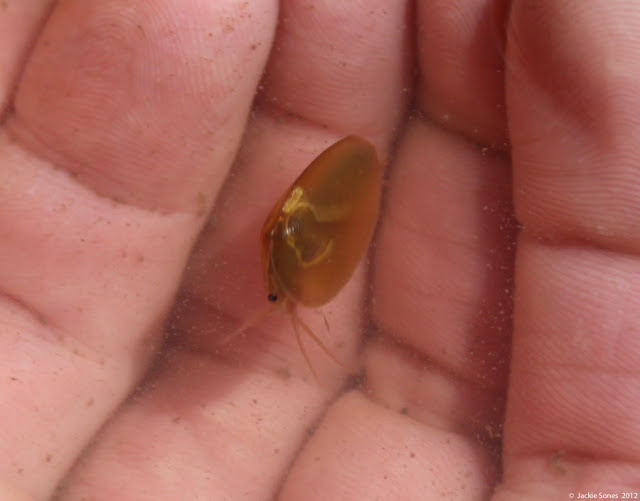On 26 May 2012, we were watching a Great Egret hunting in a shallow pool in the dunes. We wondered what it was catching, so walked up to the edge of the water to try to find out and were surprised to see these beautiful, golden, dime-sized animals swimming by, skimming over the surface of the mud.
We don't know if the egret was catching these small crustaceans, but we spent some more time with them as it was the first time that we had seen clam shrimp.
I think this is a California Clam Shrimp (Cyzicus californicus). Clam shrimp are small crustaceans with a bivalved carapace surrounding their shrimp-like bodies. They belong to the Class Branchiopoda, which also includes water fleas (Daphnia), brine shrimp (Artemia), fairy shrimp, and tadpole shrimp.
The photo below was taken in a small field aquarium. You can see the shrimp's appendages through the transparent shell.
Note the long branched antennae that are used for locomotion.
Sometimes the clam shrimp swam above the sediment, other times they ploughed along at the surface.
Here's a photo in the hand for scale. Note the two black eyes.
We saw quite a few pairs of clam shrimp, where it appeared that one individual was holding on to a second at the edge of the shell. I'm guessing these were mating pairs. I've read that the male will grasp the female's carapace and then insert his trunk between the two valves.
I'm still not completely clear on reproduction, but this is my best interpretation so far (it's hard to find information about clam shrimp!).
Females carry the eggs in a mucous mass between their bodies and the carapace (see below — I think the yellow dots are eggs).
After a while she lays the eggs on the bottom of the pool where they can withstand the dry season in a desiccation-resistant cyst-like stage. They hatch with the first rains and go through several molts in a swimming stage before producing their bivalved shell.
Clam shrimp take a long time to mature, approximately 40 days, so they require relatively large pools with long hydroperiods (holding water for a substantial period of time). They primarily occur in ephemeral pools (vernal pools) and seasonal wetlands that dry out for part of the year.
This unusual animal is a California endemic (not found outside of the state). We're lucky to have them on the Bodega Head peninsula!
Here's one more image — a scan of an empty shell we found at the edge of the pool. Although broken, it's a nice view of the shell with prominent concentric lines. We're wondering if these are growth rings?
If anyone knows more about clam shrimp, please feel free to correct or add any information.








1 comment:
Hi Jackie,
I see this was posted a while back. I am studying some clam shrimp in Australia and I'm searching the internet (as you did) looking for info on mating. Can you tell me, in the second last photo- the female with the eggs (yes the yellow blobs are eggs)- did the female appear to be alive? or was she just laying there, dead and egg laiden? The clam shrimp in my tank seem to have taken egg laiden females captive, longer term than a casual coupling and I'm wondering if they let them go alive, or just deposit them dead. I'm sure it's a distant memory to you now, but any info welcome. By the way, yes they are growth rings. Cheers, Claire
Post a Comment